#in conclusion go read a article about miyazaki and his son and then go watch the movie it’s probably going to be one of my favorites
Text
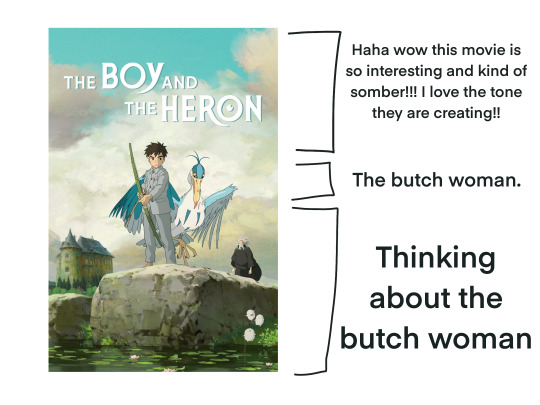
Mostly spoiler free summary of my viewing experience
#The boy and the heron#how do you live#studio ghibli#ghibli#in all honesty that movie was legitimately so fantastic and im like changed as a person#Story wise as well! It hits really hard if you know a bit about miyazaki and his legacy. Its a very personal movie i think#And you can feel it in every aspect#The eng dub voice actors were really good as well and the animation was beautiful as always#Also really loved the tone!!! The story really relied a bit on the use of negative space in both sound and pacing and i enjoyed that alot#in conclusion go read a article about miyazaki and his son and then go watch the movie it’s probably going to be one of my favorites#image id in alt
12K notes
·
View notes
Text
Studio Ghibli; and the aesthetic of comfort and the mundane.
When it comes to animation movies, Studio Ghibli movies are still some of the long standing staples of the genre, and for a good reason. A lot has been said about these films, their thematics, their characters, their stories and the studio that made them, as well as one of their elusive and yet most well known creators : Hayao Miyazaki. I will try to focus on the ways Studio Ghibli views comfort as well the coziness in these little slower moments that fill the universe of Ghibli films. These movies are generally universally loved by the public, despite the fact that they are aimed toward a younger audience. These movies are definitely created with the goal of showing it to a public of children and families, and yet they still are very complex and layered pieces of art and animation that all audiences can appreciate. These movies also do not look down on their audiences, they do not shy away from touching upon more difficult themes such as war, loss, and fear, in a manner that’s adequate for the public it is targeting. With this article, I want to write an extension on the article I have already written on the subject of slowness in cinema and that has been asked by one of my subscribers on patreon. If you haven’t read that article yet, you can read it HERE on my blog.
The films that have been created by Studio Ghibli, are, and with reason, a cornerstone of the animated movie industry. Despite the fact that these movies are definitely intended and made for a younger audience, I think we can all agree that these particular movies can be appreciated by everyone, at any age, and that anyone can find meaning and solace within these movies. Studio Ghibli movies are truly an excellent example of filmmaking that manages to capture a slower pace in media, slowing down the action to just offer a moment to breathe. Between all of the grand adventures and events that are happening in those movies, there are always moments of slowness to be found. Of calm. Of quietness. The characters of the Ghibli universe are permitted to simply exist sometimes.

The concept of slowing down in media is one that I deeply appreciate for the way it brings depth and serenity in stories. This is a very personal point of view of course, I find the modern pace of capitalist life deeply alienating at times, and sometimes I think we just need a moment to slow down and enjoy simply being. Doing nothing is a very anti-capitalist thing, in my opinion, and I greatly appreciate seeing this concept in books and movies. While being productive is always a nice feeling, and god knows I always enjoy being busy and having things to do, it is always in these moments where I feel submerged by everything I have to do that I yearn for some peace and quiet. While it is not always possible to have this, it is always possible for me to simply … start a movie, and try to escape a bit the weight of the world.
I personally think having these moments to be able to just breathe and be truly enriches a movie. Those moments of simple mundanity and ordinariness ground the story in reality even when the story is about a wizard living in a moving castle. Studio Ghibli movies are the epitome of films that can focus on fantasy and the imaginary and telling incredibly original stories, while also including this measure of the mundane, the routine and the ordinary in between the louder and more action-packed parts of the film. This way of constructing these films, makes it so that the universe feels more lived-in, real and comforting, the characters feel more grounded and rooted in reality.
Studio Ghibli: a brief history
Even though Hayao Miyazaki started working as an animator in the 1960s, working in TOEI animation and learning the tricks of the trade, it is only later in 1985 that he established Studio Ghibli as we now know it, with the partnership of Isao Takahata and Toshio Suzuki. It is with that previous working experience that he got to truly construct an identity as the type of animator he wanted to become, and the type of movies he wanted to produce. Before Ghibli, Miyazaki got involved with different animation projects such as Heidi (1974) , and Anne of Green Gables (1979) and a project that would never see the day : Pippi Longstocking. This project is quite interesting in how it simply … never got made, its a bit like a lost part of history, a what-if. Despite the fact that Hayao Miyazaki had drawn a lot of concept arts as well as storyboards for this project, they never got the green light from the swedish author Astrid Lindgren.

Nonetheless, it is obvious how all of these projects forecast how Miyazaki and his business partner Isao Takahata will more often than not try to center young girls as the main protagonists of their movies. A trend that will continue on for the most of their careers to this day. They will continue to focus on young girls and women as the main characters of the stories they are telling in such a complex and intricate way, all of their female characters are different from each other, with their own complicated inner lives, dreams and goals. It seems like such a basic requirement to request from our media, and yet even now, it is still not something that… will be guaranteed in the stories we consume. It is not to say that ghibli’s portrayals of women is perfect, but I do appreciate their very complex heroines and their adventures.
I will not try to pretend that I can totally understand the type of person that Miyazaki is, he’s a complicated figure at the helm of Studio Ghibli, the man behind the curtain. He is definitely a hardworking and self-critical person, but also deeply critical of others as well, wanting to set up very high standards of work that can be extremely difficult to achieve in a very high pressure environment. Thus is the complex personality of Miyazaki. I do not want to pretend he is a perfect man, and I do think some of his choices are things i don't quite agree with. There are some very valid and legitimate criticisms to be made about him, some by the closest people he works with as well as his own sons, especially Goro Miyazaki, who say that his father was always very distant, working long hours even by the era’s standards, and whose heart was obviously more into his work than his home life. Hayao Miyazaki valued work and putting in the time and effort into his art and job, pushing for very unhealthy job practices and work culture.
He is far from perfect, and seek perfection in his work, both from himself and the people he works with. There’s a lot to be said on that aspect, and yet I still very much think that he is that he is still a very fascinating person to reckon with, someone who brought very important and beautiful stories and revolutionized the world of animation in a really significant way. The universes he created are some I keep coming back to times and times again. I also highly recommend the documentary A Kingdom of Dreams and Madness (2013) if you have not seen it, as to have a glimpse of the way this animation studio functions on a daily basis. I find it always so very inspiring personally, each time I watch this documentary, I feel hugely motivated to create and to make something, no matter how small. Sometimes, it is simple about the sheer act of creating something, of spending some time away on the roof, looking at the skies while a cat is sleeping next to you.
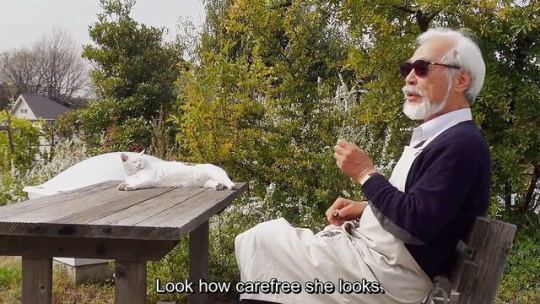
His involvement with the Union during his early animator years left him with a leftist tendency that will continue on during his career and seep through the themes of his movies.From the very firmly anti-war stances to the pro-environmentalist and anti-capitalist and anti-consumerist themes, Ghibli movies are a proof that you can tackle these subject matters in a very conscientious way even in children’s media. It can be seen in the movie Grave of the Fireflies (1988), a heart-wrenching movie about two children trying to survive the last months of World War II. Even though Isao Takahata, who directed this movie, says the movie was not made out to be an anti-war movie, this stance is still very much woven in the very fabric of the movie, from its beginning to its ending.
This specific theme is very important here in terms of the experience of the mundane and the ordinary in Ghibli movies. Even within the most devastating of events, smaller moments of slowness can be found, and appreciated. Quiet moments of peace that feel even more poignant in the midst of struggle. Despite everything, I think we have all come to the conclusion that even when world-shattering events are happening, life truly must go on. And it does find a way to go on, and it feels mind-boggling that we all have to do our groceries, cook dinner, wash our laundry while terrible events keep happening, and yet, these mundane moments still occur. It is still possible to find a moment of respite and peace in the midst of uncertain times and terrible events.
But also, as Marco says it in Porco Rosso, « I’d much rather be a pig than a fascist » and I think this really does say it all.
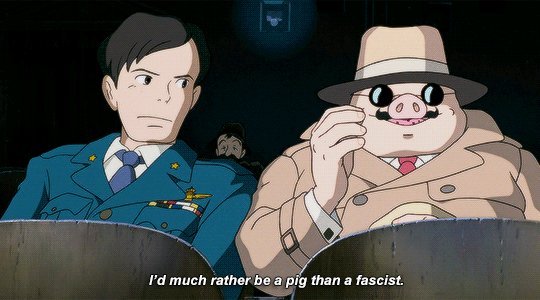
The aesthetic of comfort
Despite being usually an animated movie set in a very obviously fantastical universe, Studio Ghibli movies tend to be very realistic in the way they portray the characters, their complexity, and also what are the real underlying conflicts. For example, in Kiki’s Delivery Service (1989) «The primary conflict isn’t about magic—it’s internal and invisible and wholly human: Kiki’s brief period of lost motivation and artist’s block. She gets it back when she wants to help Tombo, whom she loves. Simple as that. She doesn’t have to wage an epic battle to prove her worth» The stakes might seem lower in this movie compared to other stories, very mundane and ordinary, there is no war, there is no significant conflict, but I think this is what makes it so special in the end.
One of the particularities of Ghibli movies is how they deal with the notion of childhood, a notion that few animation movies have approached with such delicateness and seriousness. One of the things I really appreciate from Ghibli movies is that it does not shy away from treating children as complex beings. It does acknowledge the fact that children are also able of complexities and of understanding more than we think they do, and yet creating media that is easy for them to comprehend and appreciate, which I think is no small feat.
There is definitely also a definite focus on working class characters instead of the more “prestigious” ones in Ghibli movies, there is a desire to center normal people, whatever that means, in their stories. Most of the characters have to work for a living, earn their lives, and the value of hard work is definitely something that is highlighted in the Ghibli universe. In Kiki’s Delivery Service (1989), the baker’s wife tells the young witch that work is work no matter how small and insignificant you might think it is, and all work should be paid, and it is a truth that should be remembered.
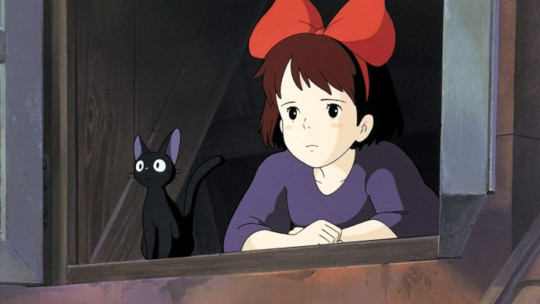
In that movie, here is no world shattering events, no wars or massive destruction, only a young witch trying to make something out of herself, losing her will and creativity and gaining it again. That particular theme is one that resonates a lot with people on a very basic level, especially in this current day and age where so many of us are trying to monetize our creative work. So often, trying to capitalize off a hobby and enduring the bone deep dreary weight of capitalism is what will make artists lose their original inspiration and will to create, when a hobby turns into labor, and this is, at its core, the journey that Kiki went through.
As Robert Ebert told Miyazaki, during an interview with him « I told Miyazaki I love the "gratuitous motion" in his films; instead of every movement being dictated by the story, sometimes people will just sit for a moment, or they will sigh, or look in a running stream, or do something extra, not to advance the story but only to give the sense of time and place and who they are.»
And he was right, Ghibli movies have these moments where the action is not something that is strictly essential to the plot of the movie, and yet it is essential to the essence of what Ghibli movies do. Miyazaki then explained what this concept for him meant for him :
«"We have a word for that in Japanese," he said. "It's called ma. Emptiness. It's there intentionally."»
Those slow moments between the actions are thus very deliberate, they mean to slow down the story and to slow down the pace. Unlike the generally accepted school of thought in modern Hollywood cinema, where every single scene and dialogue needs to move the story forward, Miyazaki lets his story and movies breathe and exist. This way of building a story does give it an added sense of calm and soothingness, but also it gives it a sense of realism. Instead of following a strict narrative outline, this fluidity makes the story feel more real and relatable.
These quiet moments and details that might seem innocuous and useless at first glance, and maybe look like they would slow and hinder the pace of the movie in itself, are ultimately what gives it this feeling of genuineness, of sincerity. It lets the characters as well as the plot have the space to breathe, evolve and grow.
« Although these scenes may seem slow or unimportant, they give space to develop the characters and to heighten dreams or feelings the characters are having such as feelings of isolation, wonder, or anxiety. It is in these moments of stillness that the audience can contemplate with the characters and feel what the characters are feeling. These moments remind the audience the importance of stillness in such a fast paced world and highlights the beauty of a slower paced life»
Studio Ghibli movies insert those slo
wer moments in between their more faster paced and action packed scenes, but also in the midst of world-changing events such as wars, as shown in Howl’s Moving Castle (2004). This demonstrates how people still live on during those crises, even with the danger looming over their heads. This kind of media gives me hope that we can live through this, that moments of happiness and peace are still to be found even within the madness of our very fast capitalistic and hyper consumerist life.
From visibly established routines to a focus on the mundane, the daily. the ordinary, Ghibli movies will definitely bring these seemingly unimportant acts and integrate them as essential to the general experience of the movie. You see the characters inhabiting the Ghibli universe working, studying, sleeping, eating, in a way, you see them being alive. In a manner of speaking, of course, these are fictional characters in fictional universes, but it is obvious that the universe and the lives these characters lead extend beyond what we’re seeing on the screen. They have whole lives and experiences that we might not be privy to, as the audience, but it is apparent that these characters are fully formed. They are going on and about with their lives, and it is this emphasis on the ordinary that makes them appear so realistic.
Falling and getting up again. Jumping and stumbling. So often, Ghibli’s characters are not perfectly graceful beacons of dexterity and elegance, quite the opposite even, their demeanor and posture will inform the character and their place in that world, and yet it is not always perfect and flawless. Sometimes, the characters will run and stumble and trip and fall and this mundanity of being.
This representation of the realness of what it is to be a person, that sometimes we trip and stumble, that we fall and get up again and yet, we continue to walk or run. It’s also a way of defining the different characters, of imbuing them with their own personality and mannerisms and be able to distinguish them even with such small details as the way they walk and carry themselves. This is definitely not exclusive to Studio Ghibli, animation as a whole uses movement and mannerisms as an essential tenet of character, but it is still very rare to see this sort of flailing included voluntarily in the films. Since the medium that these movies are created in is two-dimensional animation, it means that every single frame had to be carefully planned and executed, before being drawn and painted frame by frame. These movements could have been easily not included in the final cut of the movie, they could have been considered superfluous to the film, and yet they were. These imperfect moments are what ultimately makes it better.
Ghibli movies do that, not only in terms of physicality and concrete elements, but also when it comes to feelings and emotions. Emotions that we all feel and experience, from the feeling of restlessness to loss and fear, to love and courage. Ghibli movies really do showcase all of these feelings that we all feel, even though in a manner that is easy to understand for all audiences.
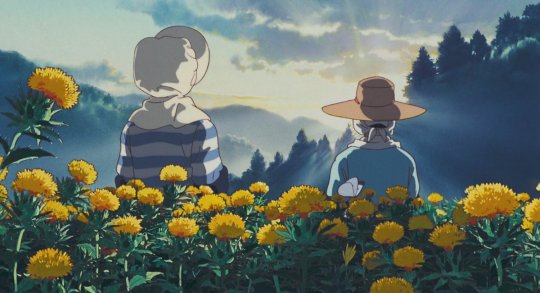
“Only Yesterday does not hit the dramatic highs of Miyazaki’s work, but that’s partly the point. It’s less concerned with presenting a grand thesis about the nature of being human than it is navigating the heartbreaks, triumphs and regrets that make us. But it’s still comforting for a film about the relentless march of time, the title even invoking both the speed with which childhood can pass us by and how close those memories stay with us.
It’s immensely relatable in how it evokes these little tragedies: the feeling of being a fraud; of missing out’ of wondering if you’ve left your childhood self behind; idealism; dreams and all. It asks us not to mourn what might or might not have happened, but to keep those memories close, and use them to move forward. That Only Yesterday makes this feel as wondrous as a castle in the sky or a land of spirits is nothing short of miraculous, and why it ranks among Ghibli’s best.”
The act of eating is one that is heavily emphasized in Ghibli movies, one only needs to read all of the articles dedicated to the mouth-watering food that fills its universe to understand that this simple act, of eating and of preparing food, is one that is very important. Countless of people have made videos on how to recreate some of the most iconic dishes and meals of the Ghibli universe, from Howl’s Moving Castle’s tempting breakfast to Spirited Away’s feasts, both the one that Chihiro’s parents eat at the beginning of the movie and the ones served to the bathhouse’s guests, and the simple snacks that are eaten throughout the movie, from the onigiri Haku gives Chihiro or the food she shares with Lin. Ghibli movies are very well known for how pretty and appealing its food looks, and simply taking the time to showcase the act of preparing and eating food, thus slowing down the pace and creating a break during the plot of the movie. There’s a certain type of media that does put a lot of importance on the act of slowing down, taking the time to cook, such movies such as Little Forest : Summer & Autumn and Little forest : winter and spring, for example. A lot of media that’s just about not doing much and preparing some food, which somehow has a very soothing effect. The act of eating and cooking is part of the greater character narrative and storyline when it comes to Ghibli movies, but also the act of sharing a meal and of eating together.
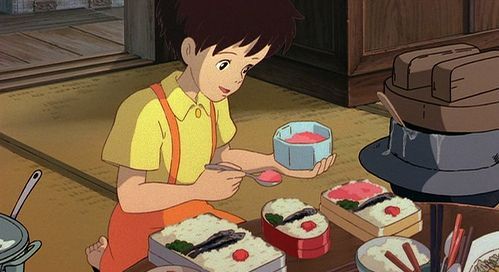
Food, the preparing of food as well as the sharing of a meal, is a love language in itself, in my very humble opinion, taking the time to prepare all of the ingredients and then a dish for someone else or for one self is an act of care. And it is definitely one of the ways it is used in Ghibli movies, from My Neighbor Totoro (1988) in which the eldest daughter is often seen having to prepare lunch and food for her younger sister and her father, since her mother is sick and hospitalized. I will not be talking here about eldest daughter syndrome here, but it is very much a Real Thing™️. It is simply in this representation of the act of cooking, and the care she puts in it, that we can understand not only the love she has for her younger sister and father, but also the very real responsibilities that she has to shoulder as such a young age.
In every single Studio Ghibli movie, this pattern appears, someone will make food, and it will be obvious how much time, effort and love it takes to prepare this dish, or someone will simply take a break from whatever they were doing and take a bite of a small but tasty snack. Somehow, the usage of food in the Ghibli universe is central to the way the characters will experience and move through the world.
It is in these small moments of respite and calm that the characters, and by extension, us, are allowed to breathe. Moments that are quiet, where two people will share a meal and just be. I always terribly appreciate whenever a movie, or any piece of media really, simply takes the time to let the story expand and move at its own pace. Studio Ghibli movies are always ones I love to go back to whenever the world feels overwhelming and slightly unbearable. I hope that we can all have more moments of peace and quiet, that things can slow down enough for us to catch our breath.

BIBLIOGRAPHY:
Hayao Miyazaki interview | Interviews
The Magic and Artistry of Studio Ghibli's Films
The Low-Stakes Pleasure of KIKI’S DELIVERY SERVICE
Wings and Freedom, Spirit and Self: How the Filmography of Hayao Miyazaki Subverts Nation Branding and Soft Power Shadow
Miyazaki’s Magical Food: An Ode to Anime’s Best Cooking Scenes
Food in Spirited Away: Consuming with Intent
Grave of the Fireflies: The haunting relevance of Studio Ghibli's darkest film
NAPIER, Susan. Miyazakiworld : a life in art. Yale University Press, 2018.
75 notes
·
View notes